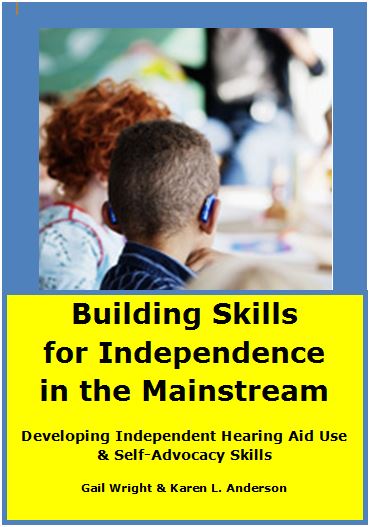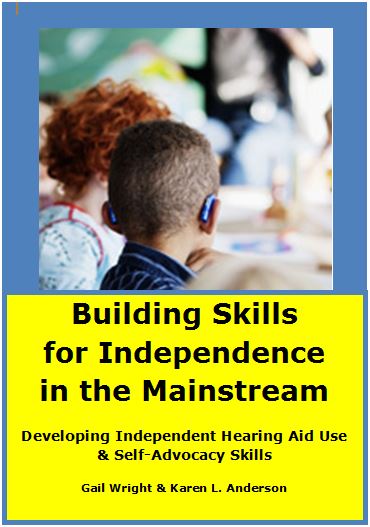Related Products
For Professionals
- Amplification
- Assessment of Student Skills, Challenges, Needs
- Early Childhood: Infants, Toddlers, Preschool
- Hearing Loss – Identification, Impact and Next Steps
- IDEA Law Summary Information
- Language and Speech Development Issues
- Legal Issues in Serving Children with Hearing Loss
- Listening (Auditory Skills) Development
- Planning to Meet Student Needs
- Self-Advocacy Skills for Students with Hearing Loss
- Self-Concept: How the Child with Hearing Loss Sees Himself
- Social Skills
- Speech Perception & Learning
Related Teacher Tools Takeout Items
Social Needs & “I hate my hearing aids!”
There is no magic single solution to keeping hearing aids on students as they enter the tween/teen years.
Why do kids reject their hearing aids – they help them so much!
It is ‘normal’ to want to ‘be normal’. All children struggle with this to some degree. Rejecting hearing aids is usually an emotional reaction to wanting to fit in. As children approach adolescence, how they view the acceptance of their peers is very powerful. Being an accepted member of the social group becomes increasingly important. Taking off the hearing aids, saying they don’t need hearing aids and pretending to ‘be normal’ are all emotional reactions to trying to ‘solve the problem of fitting in.’
To the child, not wearing hearing aids is a solution to an uncomfortable social/identity situation. Ironically, it is the students with mild and moderate hearing loss – those who can hear closest to ‘normal’ with amplification – who are at highest risk for rejecting their hearing aids because they can ‘hear’ and are willing to try to ‘get by’ with the hearing that they have.
Also refer to the webpage Addressing Self-Esteem and Issues of Fitting In and Why do so Many Students that Function with Mild Hearing Loss have Challenges Fitting In? at Mild Hearing Loss & Learning and to Being the Lone Student with a Hearing Loss at Relationship of Hearing Loss to Listening and Learning. The report Psychological Affects of Hearing Loss In Teens provides insights, especially for children who have recently lost their hearing.
Won’t it help if I explain and ‘show’ the student how much better s/he does with hearing aids?
It is likely that the student realizes that communication is more difficult when the hearing aids are not worn or that they miss a lot more teacher information when they don’t wear the FM in the classroom. Providing them with the numbers will quantify this difference to the student, but it is unlikely to make him change  his mind long term about wearing hearing aids since the uncomfortable reality of feeling as though he is ‘weird’ or ‘doesn’t fit in’ is still unresolved. Similarly, firm expectations and behavior contracts may work in the short-term, but are not likely to make a long term difference. That said, it is still important for the child as a consumer to be able to understand his hearing loss and what he can/cannot hear. The hearing loss will be with the child his whole life and he will be asked countless times about it. He needs the language to describe to others so they can understand what the hearing loss means in terms of the person’s communication needs and expectations for his/her communication partners.
his mind long term about wearing hearing aids since the uncomfortable reality of feeling as though he is ‘weird’ or ‘doesn’t fit in’ is still unresolved. Similarly, firm expectations and behavior contracts may work in the short-term, but are not likely to make a long term difference. That said, it is still important for the child as a consumer to be able to understand his hearing loss and what he can/cannot hear. The hearing loss will be with the child his whole life and he will be asked countless times about it. He needs the language to describe to others so they can understand what the hearing loss means in terms of the person’s communication needs and expectations for his/her communication partners.
Some students don’t seem to have these struggles while others start to reject their hearing aids by the 4th grade – what’s the difference?
To really ‘fit in’ to a group of typically hearing children the child with hearing loss needs to have age-appropriate social skills, be aware of subtle social cues and also have high self-esteem to admit they have a hearing loss (disclosure) and be willing to take the emotional risk of advocating for their communication needs. Underpinning these skills is a strong self-concept and identity as a person who is likeable and capable. Some children are raised with mixed messages that result in them internalizing that their hearing loss is a problem that separates them from being the child that their parents wanted (see Attitude is Caught, Not Taught). In this situation, rejecting the hearing loss (and hearing aids) is an attempt to make themselves more acceptable in the family setting. Emotional ‘loyalty’ to family attitudes can interfere with the child’s openness to recognize that hearing aids are necessary for learning and academic success. Alternately, some children come from families who have embraced them as ‘just kids who happen to need hearing aids’, treating use of the devices as matter of fact as needing to wear shoes, and as recognizing them as being special just for who they are. Coming from a ‘celebration and acceptance of differences’ value base from an early age goes far in providing a child with the resilience needed to answer the questions of curious peers and feel good about ‘cool technology.’ Of course there are some children who come from very supportive families who still reject their hearing aids, perhaps due to lack of resilience to negative peer comments or as a part of identity struggles due to other challenges unrelated to hearing loss that can cause a child to feel as though they do not fit in.
Early intervention services that include discussions of social development needs and connect families of children with hearing loss are an important contributors to the attitudes that develop children’s view of themselves. Once a child is in elementary school (by age 5) it is critical for them to have ongoing connections with other children who use hearing technology. Use of the hearing devices must become part of their identity and our identities are largely formed by our social groups. Children who are only surrounded by peers with typical hearing will be much more likely to reject hearing aids as a way to fit in. Identity is key!
Another thing to keep in mind is that adolescents are more likely to reject anything they felt ‘has been done to them.’ This is why it is so important to encourage the child to be involved in choosing hearing aid or earmold colors, asking the audiologist questions or and being responsible for their hearing devices as early as possible. If they’ve invested themselves and been recognized as being their own “Technology Specialist’ then they may be less likely to feel as though they were a bystander in the decision to wear hearing devices.
Viewpoints of tweens & teens
Adolescents are concerned with how they appear to others. They are trying to reconcile “the person I am” with “the person society expects me to become.” They establish this new sense of self by using past experiences to guide their anticipation of the future. When the adolescent finds a balance between “What have I got?” and “What am I going to do with it?” they will have established their identity. DHH professionals with long experience probably know of some students who rejected their hearing aids in middle school, only to return to using them in high school, whereas others never used amplification again. The difference is likely rooted in whether or not their developed identity included a central view of themselves as a person with hearing loss or a view of themselves without the hearing loss (but possibly a view of learning challenges, inadequacy, ‘can’t do school’).
Research by Elkayam and English (2003) identified that teens were experiencing the following themes:
1. Inherent isolation of hearing loss: feeling left out of conversations; others just can’t understand what it’s like to have a hearing loss; futility of talking about it with friends as frustration still occurs 2. Identity and self-concept: difficulty being the only one in school with hearing devices; preference for being with other students with hearing loss and support staff because they understand; challenges finding a social niche; easier to be viewed as deaf but missing information sometimes rather than hearing ‘perfectly’ 3. Cosmetics and other hearing device issues: hate having to explain to people; seen as being different
4. Problem solving: classroom can be easier than social situations; need for assistive devices; challenge of rapid speech, whispering, person turning away, background noise
5. Self-acceptance: blaming others for communication difficulties; desire for normal hearing; downplaying need for accommodations when challenged by teachers (“just forget it”); something just to deal with; being unique.
6. Special Considerations for Parents Raising a Teenager with Hearing Loss is a brochure about supporting full time hearing aid use by teenagers.
Cosmetics and other hearing device issues: hate having to explain to people; seen as being different
4. Problem solving: classroom can be easier than social situations; need for assistive devices; challenge of rapid speech, whispering, person turning away, background noise
5. Self-acceptance: blaming others for communication difficulties; desire for normal hearing; downplaying need for accommodations when challenged by teachers (“just forget it”); something just to deal with; being unique.
6. Special Considerations for Parents Raising a Teenager with Hearing Loss is a brochure about supporting full time hearing aid use by teenagers.
The Effects of an Untreated Hearing Loss on Workplace Compensation
Possible prevention…
Part of these issues need to be prevented, by building strong self-concept and strong self-esteem from a young age. All of these issues need to be acknowledged and openly discussed by the time students are tweens to help the student become aware of “What have I got?” as a foundation for being able to positively visualize “What am I going to do with it?” as they move through adolescence.
In elementary school – certainly by the end of 4th grade – the early tweens are already aware of trying to reconcile “the person I am” with “the person society expects me to become.” If “the person I am” is the only child with hearing loss in the whole grade/school, then “the person society expects me to become” is likely to be internalized as someone without hearing loss. At this juncture it is important for students to be connected with peers who also have hearing loss and communicate/wear hearing devices like them. Being exposed to role models a few years older who willingly use hearing devices and advocate for themselves would tremendously increase the chance that the child would develop a positive  feeling about being a member of the group of “successful/cool kids who wear hearing devices.” Discussing how the students feel about their hearing aids, tasking them with describing their hearing loss to one another, developing a sense of group by sharing ‘oh no, guess what happened to me’ stories and brainstorming ‘you could have done/said this’ in the group will strengthen the sense of valued membership
feeling about being a member of the group of “successful/cool kids who wear hearing devices.” Discussing how the students feel about their hearing aids, tasking them with describing their hearing loss to one another, developing a sense of group by sharing ‘oh no, guess what happened to me’ stories and brainstorming ‘you could have done/said this’ in the group will strengthen the sense of valued membership
In addition, it is very important to also bring hearing peers into the discussion so that the student with hearing loss can understand, first hand, how peers view them in light of their hearing needs (SOAC-A checklist is suggested). Children need to reconcile themselves as part of the group that has hearing loss/wears hearing devices AND the group of age-peers in school who do not have hearing loss, rather than only the typically hearing group if they are to be emotionally as well as academically successful individuals. Also putting them in the important role of being their own ‘Technology Specialist’ can provide a source of pride and growing independence as they are better prepared to answer questions about their hearing technology – and kids really like technology, peers included.
Teen connections
Hearing Our Way Hearinglikeme.com
Hearing Journey (Advanced Bionics)
Are there resources available?
There are a variety of resources in Chapter 5 of Building Skills for Success in the Fast-Paced Classroom that have been developed or included to provide a format for conversations with children that will help them explore their feelings about being a person with hearing loss. The Peer Relationship Scale,
Self-Assessment of Communication – Adolescent (SAC-A), and
Significant Other Assessment of Communication – Adolescent (SOAC-A) are available for download from the Tests by Other Authors section of this website. Other resources from Building Skills are:
- You and Your Tricky Hearing Loss
- The Secondary School Survey (don’t wait until middle school – grade 5!!!)
- Various exercises related to feelings
- Teasing – It happens to everyone
- Hearing Technology and You: Your idea of the perfect hearing device
- Living in the World with Hearing Loss: What other people may think
- A Wizard’s Challenge game
Being able to consider themselves part of a group of other children with hearing loss and having the opportunity to talk about common issues can go a long way toward a more positive self-identity. Social group options through the school district or organized by the state may result in better test scores as more students keep their hearing aids on!
It is critical for early interventionists, preschool settings, schools and audiologists to connect families of children with hearing loss together so that kids can spend time with other kids who use hearing devices. It is every bit as important for the family members to encounter other families with ‘cool, successful kids’ who happen to have hearing loss. There are some handouts available for families regarding self-esteem building at the end of Chapter 5 in Building Skills that may be most useful for young students.
Rejection may also be due to problems with amplification!
In 2008 a study (Franks) investigated why students age 8-18 resist wearing FM amplification. Results indicated that there was no correlation between type of hearing loss (unilateral, bilateral) and resisting hearing aid wear. At least half (53%) believed that the primary reason for non-use was social. Students said:
- It makes you stand out.
- Students ask me “What is that?¨ I really dislike that.
- Mine used to always make weird loud noises that attracted attention to me
- It is annoying.
- If students didn’t grow up using the FM units, they don’t feel comfortable with them.
- Teacher forgets to use it.
- I don’t feel it makes a huge difference because I can just ask my friend if I think I missed something.
- I don’t like the fact that I have to give it to the teacher.
- I feel bad teachers have to use it.
Notice that some of these issues are due to poor functioning equipment, others to resistance from teachers and others from a lack of self-esteem on the part of the student to have the resilience to endure standing out when wearing the technology or self advocating. Results indicated reasons for resisting using FM equipment as: 15% mechanical issues, 10% comfort, 10% questioned benefit, 15% lack of support of teachers, 10% inconvenient to manage FM between classes/recharging.
Problems that are solvable with aggressive management (Johnson, 2011)
Technology
- Provides more flexibility to hear peers
- No bulk or less bulk to hearing technology

- Connectivity options
- Cool technology
- Must include aggressive troubleshooting
School/Teachers/Staff
- Hearing loss awareness: hearing vs. understanding
- Classroom support
- Orientation and training
- Enforcement: If in IEP or 504 use of hearing technology is not a teacher’s choice
If a student is resisting using their hearing devices, be sure that the devices are working properly, comfortable and that the student and staff clearly understands the benefit and use.
Making sure that these issues are aggressively and consistently addressed AND providing social/group support discussions of emotional issues seem to be an appropriate means to support students with hearing loss so they can perform as competitively as possible in the mainstream. Better student outcomes at graduation mean a better future!
My thanks for the insights provided in the following references: Schlesinger, H.S. (1978). The effects of deafness on childhood development: An Eriksonian perspective. In L. S. Liber (Ed.) Deaf Children: Developmental perspectives (pp. 157 – 169). New York, NY: Academic Press. Elkayam, J., & English, K. (2003). Counseling adolescents with hearing loss with the use of self assessment/ significant other questionnaires. JAAA, 14(3), 486-499. Franks, J. (2004). Why do students with hearing impairments resist wearing FM amplification? Unpublished Masters Thesis. Johnson, C. (2011). “I don’t want to be different!” Strategies for Reluctant FM Users. Clarke Mainstream Conference, Northampton, MA (October).Printable version – 4 pages: Social Needs & “I hate my hearing aids!”
These are the views of Karen Anderson, PhD who reserves the right to adapt them as she learns more from the literature and the many DHH professionals and parents who are helping students deal with these issues everyday.
Original post March, 2012 (c) Karen L. Anderson, PhD
Updated January 2016.





